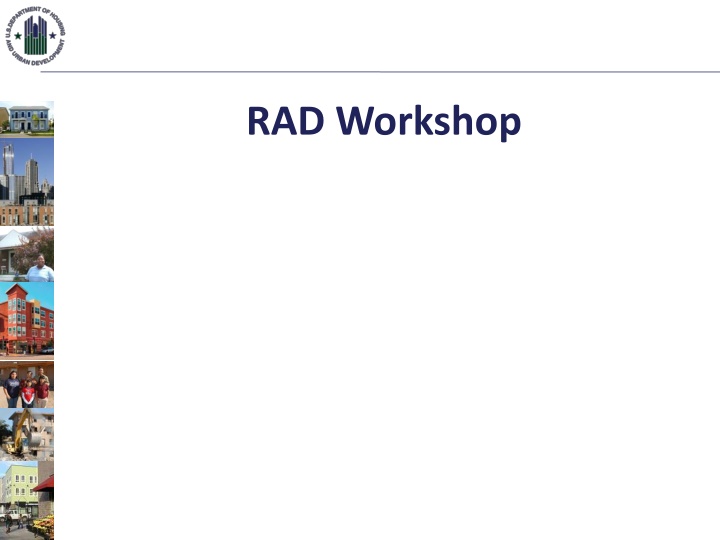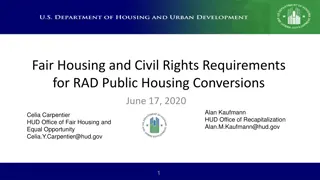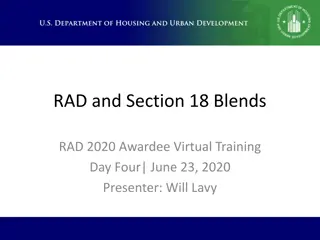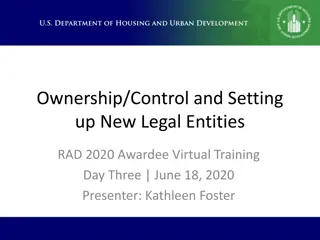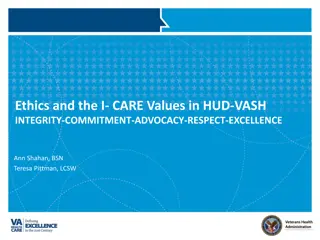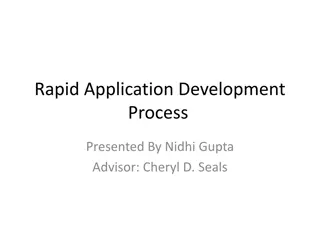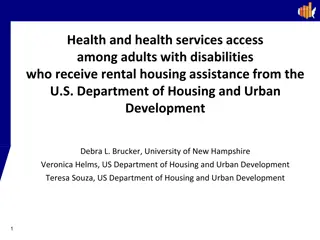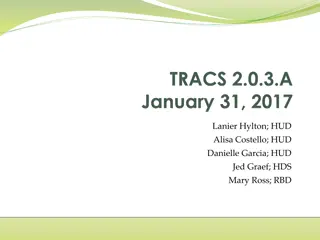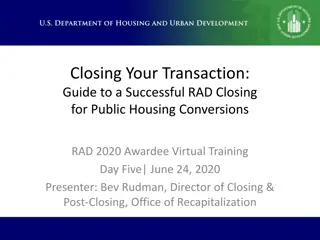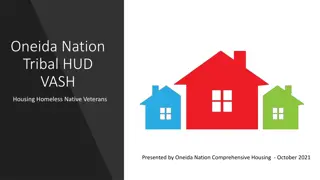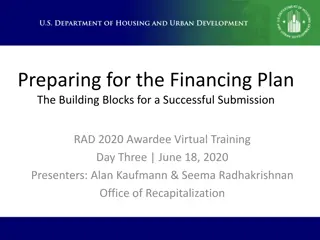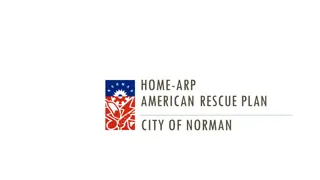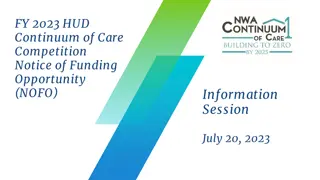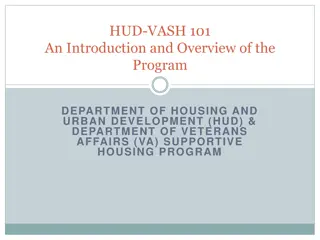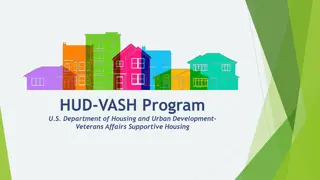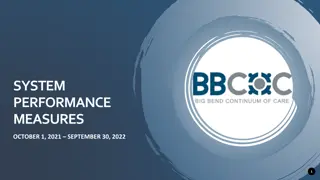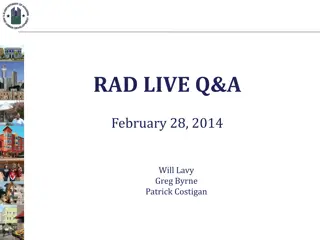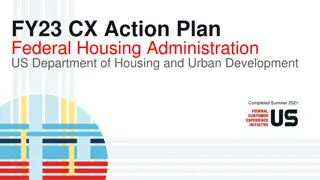RAD Workshop: Understanding HUD's RAD Program
The RAD Workshop provides detailed information on HUD's Rental Assistance Demonstration (RAD) program, including its benefits, eligible developments, impact on residents and PHAs, and resources for conversion. Learn about public housing conversions, key provisions, post-conversion terms, and resident provisions. Explore how RAD combines housing operating and capital subsidies into Section 8 contracts and discover if your project is a good candidate for RAD. Access tools like the RAD Inventory Assessment Tool and familiarize yourself with the process of converting public housing units to affordable housing under RAD.
Download Presentation

Please find below an Image/Link to download the presentation.
The content on the website is provided AS IS for your information and personal use only. It may not be sold, licensed, or shared on other websites without obtaining consent from the author.If you encounter any issues during the download, it is possible that the publisher has removed the file from their server.
You are allowed to download the files provided on this website for personal or commercial use, subject to the condition that they are used lawfully. All files are the property of their respective owners.
The content on the website is provided AS IS for your information and personal use only. It may not be sold, licensed, or shared on other websites without obtaining consent from the author.
E N D
Presentation Transcript
RAD WORKSHOP What is RAD? HUD demonstration program that combines public housing operating and capital subsidy into a Section 8 HAP contract What kinds of developments are being done with RAD? Minor rehab; major rehab; new construction; mixed income; off-site replacement housing How do I determine if I have a project/portfolio that would be a good candidate for RAD conversion? Use the RAD Inventory Assessment Tool in the Resources section of www.hud.gov/rad How would RAD affect: Residents: No change; 30% of income for rent PHA Functions: Dependent on cash flow, fees, strong management; puts them on the more secure Section 8 funding platform; Gives them the affordable housing tools of other nonprofit developers Resources: www.hud.gov/rad; www.radcapitalmarketplace.com; www.radresource.net 2/2/2012 2
THISISRAD Sample Public Housing Conversion Per Unit Monthly $900 $800 $700 Operating Fund $330 Housing Assistance Payment $474 $600 At closing, funding is converted to a Section 8 contract rent $500 $792 Capital Fund $144 $400 $300 $200 Tenant Tenant Payment $318 Payment $318 $100 $- Pre-Conversion ACC Post-Conversion Section 8 3
PUBLIC HOUSING CONVERSIONS Key Provisions Public Housing & Mod Rehab Convert at current funding only PBRA or PBV Cap of 60,000 units Choice-Mobility, with limited exemptions Extensive waiver authority to facilitate conversion First come, first served after close of initial competitive window (10/25/2012) All applications must be received by 9/30/2015 4
PUBLIC HOUSING CONVERSIONS RAD Contracts & Post-Conversion Terms Option of PBRA or PBV contracts Long-term renewable use & affordability restrictions Secretary shall offer & the owner shall accept renewal of the contract Public or non-profit ownership or control, except after foreclosure, etc., or to facilitate tax credits Transfer of assistance to replacement units Public Housing Section 18 Demo/Dispo application not needed for conversion of substantially all units Requirements for assistance established through contracts, use agreements, regulations, etc Waiver authority for PBV, PBRA, Operating Fund, Capital Fund Evaluation 5
PUBLIC HOUSING CONVERSIONS Resident Provisions No Re-Screening of Residents at Conversion One-for-One Replacement Must convert all or substantially all units in covered project Family Self Sufficiency Current FSS participants continue in program Resident Participation & Funding PHA must recognize legitimate tenant organizations PHA must provide $25 per occupied unit annually for resident participation ($15 per occupied unit > legitimate tenant organization Resident Procedural Rights Consistent with Section 6 of the 1937 Housing Act Resident Relocation Consistent with Uniform Relocation Act 6
RESULTSOFTHECOMPETITIVEROUND Initial Public Housing Awards Total applications: 113 Total awarded public housing projects: 110 Total awarded PHAs: 68 Total awarded Public Housing Units: 11,910 PHA Size* 32% Small (<250 Units in Inventory) 52% Medium (251-1,249 Units in Inventory) 16% Large (1,250+ Units in Inventory) *Based on 68 awarded PHAs 2/2/2012 7
RESULTSOFTHECOMPETITIVEROUND Geographic Distribution: Received applications in all four geographic areas and all sizes of PHAs in those areas Largest # of awards in the South: 63 awards for 7,645 Units Capital Needs 22% New Construction 78% Rehab 24% proposed Greater than $50k in Rehab 23% proposed $30K to $50K in Rehab 21% proposed $10K to $30K in Rehab 32% proposed Less than $10K in Rehab 2/2/2012 8
RESULTSOFTHECOMPETITIVEROUND Type of Section 8 subsidy (by project) 54% Project Based Vouchers (PBV) 46% Project Based Rental Assistance (PBRA) Type of Section 8 subsidy (by Unit) 44% Project Based Vouchers (PBV) 56% Project Based Rental Assistance (PBRA) 2/2/2012 9
FINANCINGRESOURCES $977 Million in Total Financing Sources $74 million PHA supplied (Operating; Replacement Housing Factor Funds, Cap Funds, etc.) $257 million 1st Mortgage $409 million in 4% and 9% LIHTC $237 million in second mortgages and soft financing: HOME, CDBG, AHP, etc. 2/2/2012 10
NONPROFIT DEVELOPEROBJECTIVES Partner with PHAs to: Modernize aging family & elderly properties Substantial rehab of deteriorated properties Demolish/replace severely distressed/obsolete properties Thin densities/mix incomes via RAD HAPs and transfer authority Place RAD HAP contracts in off-site units in high amenity locations Increase QAP scoring by serving more VLI families New 20 year HAP contract funding 2/2/2012 11
CHOOSING THE TYPE OF SECTION 8 PBV Component of PHA s Housing Choice Voucher Program in which the PHA attaches a voucher to specific units via a HAP (Part of HUD Public Housing) Voucher funding administered by PHA PHA can earn administrative fee PBRA Provided to owners by HUD s Office of Housing via a HAP (Part of HUD Multifamily) Projects monitored by PBCA s No administrative fee to PHAs 20 years Subject to annual appropriations, but strong history of full appropriations 15 years (up to 20 with approval of voucher agency) Subject to annual appropriations but with a history of appropriation reductions
CHOOSING THE TYPE OF SECTION 8 PBV 20 year RAD Use Agreement Choice mobility option unlimited: if annual HCV turn-over is insufficient to meet CM, departing RAD residents go to top of HCV s waiting list. Contract rent setting: Lower of current funding; reasonable rent; 110% FMR minus utilities Annual Board budget approval If PBV>50% social services mandatory in family projects Waiver of provisions regarding deconcentration of poverty PBRA 20 year RAD Use Agreement Choice mobility option can be limited to 15% of the RAD project units and/or 33% of the PHA s annual HCV turn-over Contract rent setting: Lower of current funding and 120% FMR minus utilities (higher with RCS) No direct Board approval requirement on-going No HUD social services requirement
Quantifying Rehabilitation Needs For RAD application, use best available information on rehab needs, 5 year PNA, etc. Within 60 days of Commitment to enter into a Housing Assistance Payments Contract ( CHAP ), contract with a qualified Physical Conditions Assessment ( PCA ) contractor and file the completed PCA with HUD. PCA components: Compares traditional and green rehab; (Forensic research for buildings > 30 yrs. Old Energy audit Integrated Pest Management (IPM) Inspection RPCA guidance on Hud.gov/rad Not required for demolition and new construction
RELOCATION CONSIDERATIONS Unlike Section 18 demo/dispo, no additional new Section 8 vouchers are available with RAD Must be done in compliance with URA RAD HAP contract funds at construction closing Residents cannot be involuntarily permanently dislocated The cost of temporary relocation factored into the development budget Partially offset by funding of Section 8 rents during construction 2/2/2012 15
THRESHOLDISSUES Capital Fund Financing program (CFFP) Can be pre-paid, depending on loan terms HUD will waive the 5% change restriction (but lenders can enforce) EPC Typically smaller amounts Shorter loan terms Can be subordinated 2/2/2012 16
PUBLIC HOUSING RESOURCES & TOOLS Determining a PHA s RAD Rent www.hud.gov/rad Resources PHA Conversion Guide RAD Inventory Assessment Tool Fill in PHA # Populate Fill in basic financing assumptions Top rent in BOLD is RAD rent Feasibility with debt only Feasibility with 4% LIHTC & 9% LIHTC 17
PUBLIC HOUSING RESOURCES & TOOLS RAD Inventory Assessment Tool for PHAs 18
RAD FINANCING Debt Conventional Soft secondary Credit enhancement FHA Insurance FHA Mortgagee Letter for RAD transactions LIHTC Pilot LIHTCs 4% availability & considerations 9% availability & considerations 19
FHA MULTIFAMILY MORTGAGE INSURANCE Section 223(f) Refinance or acquisition Minor/moderate repairs ($6,500/unit*high cost factor) Permanent debt with repair escrow - up to 35 years Section 221(d)(4) Substantial rehab: 2 major building systems Construction/permanent debt all in one - initial/final closing 40-year financing Mortgagee Letter for RAD Transactions issued 10/12 Eligibility, underwriting criteria, processing & materials 20
FHA LIHTC PILOT PROGRAM Streamlined-Enhanced FHA 223(f) & LIHTCs Rehab expenditures of up to $40,000/unit Tax credit or Bond Cap allocation in hand Processed in Multifamily Hubs Using MAP lenders approved for the Pilot Goal of 3-4 month turnaround on applications 21
RAD & LIHTCS RAD Sweet Spot Debt Only Abt study $24k/unit average capital need Opex at $4,500 pupy + $300 replacement reserves FHA debt at 3.45%; 1.2 DCR Feasible with RAD rents above ~$610/month 22
RAD & LIHTCS RAD Sweet Spot 4% LIHTCs Rehab needs above $24k/unit to ~$40k/unit Ease of meeting 50% test with RAD rents Available P-A Volume Cap Non-competitive QAPs favoring preservation, green Evolving, accessible short-bond structure Historically low borrowing rates 23
RAD & LIHTCS Short Bond Structure for 4% LIHTCs At Closing TE bonds with 24 month term issued (1.25%) FHA 221(d)(4) or 223(f) closes During Construction Construction draws: Standard GNMA certificates Bonds paid down & paid off at construction completion Reduces negative arbitrage costs Long Term Project benefits from 40-year loan at FHA rate of 3.45% 24
RAD & LIHTCS RAD Sweet Spot 9% LIHTCs Targeted prospects for substantial rehab & replacement housing No Section 18 review Income mixing Split project (AMP) 9% LIHTC used to help cover relo/demo/first phase 4% LIHTC for balance of site RAD HAP contract(s) for off-site replacement Acquisition/rehab New construction 25
RAD & LIHTCS New Approach to Mixed-Finance Same LIHTC ownership structures Thorough PCA Standard Mixed Finance Section 18 Demo/Dispo process 1-1 replacement goal, but not required Screen for re-entry Often large gap financing requirements RAD & LIHTCs No Section 18 Demo/Dispo, but no relocation HCVs 1-1 replacement with de minimus changes, Right to return, no re-screening Choice Mobility Less gap financing needed with RAD rent structure 26
CONSIDERATIONSFOROPERATIONS Managing Operating Expenses Lower, post-rehab Will have separate replacement reserves per project Compare to other local, nonprofit operated affordable housing Powerful impact on the ability to leverage Compare RAD rents to revised opex: If opex are 60% or less of rents, significantly increases feasibility Retaining real estate tax PILOT arrangements Section 8 rent includes utilities; incentives to PHAs to reduce utilities by incorporating green measures 2/2/2012 27
COMPARISONOF PHA FEES ACC VS RAD Assume a 100 unit project, new const, $120K/unit Per unit per month Current ACC RAD Property Mgmt Fee $ 45.00 $ 45.00 Bookkeeping $ 7.50 $ 7.50 IT $ 2.00 $ - Asset Mgmt Fee $ 10.00 $ - Capital Fund Fee Cash Flow $ 15.00 $ - $ 20.00 Monthly $ 79.50 $ 72.50 Annual Annual difference 15 year difference $ 95,400.00 $ 87,000.00 $ (8,400.00) $ (126,000.00) Developer Fee (15% of $12M) $ 1,800,000.00 Payment on PHA financing ($10k annually) $ 150,000.00 $ 1,950,000.00 Net unrestricted funds to the PHA over 15 years $ 1,824,000.00
INTERNALCONSIDERATIONS Each development stands on its own PHAs have the tools of other affordable housing developers Property Managers can be empowered to manage their own operating budgets with their own replacement reserves Significantly more private leverage Properly structured projects generate unrestricted cash from cash flow, developer fees and loan payments Funding is more predictable RAD units: Require no Annual Plan Are not in PIC Staff follow one set of requirements either PBV or PBRA Site based waiting lists 2/2/2012 29
THEAPPLICATION Simple, start with basic pro forma www.hud.gov/rad Application Two resident meetings Board meeting and approval Financing letters Lender Investor If 9% credit, letter from HFA or self-scoring Choice Mobility: Letter for PBRA; ability to administer for PBV If converting a project that is currently mixed-finance, need signatures of all parties Fix Fatal Error issues CHAP Award 2/2/2012 30
CLOSINGPROCESS Post CHAP DAY 1: CHAP Issued; Transaction Manager assigned DAY 30: Information on Development Team ( One Round allowance for LIHTC; schedule subject to oversight by TM) DAY 60: Firm Financing Letters DAY 180: Submit Financing Plan DAY 360: Closing and Conversion; Section 8 begins to fund Post Conversion Temporary Relocation (if necessary) Demolition (as necessary; no Section 18 approval required) Rehabilitation or New Construction Re-occupancy 2/2/2012 31
RAD CAPITAL MARKETPLACE www.radcapitalmarketplace.com 32
RAD WEB PAGE RAD Notice, application materials, and additional resources can be found at www.hud.gov/rad Email questions to radresource.net 33
